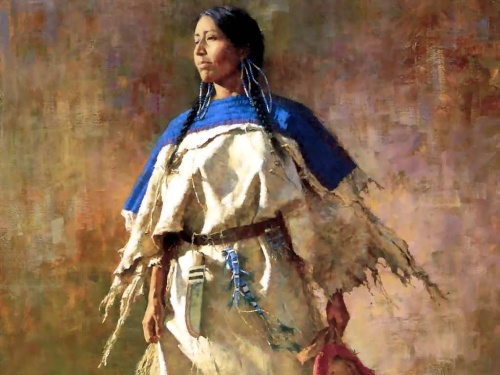 The advent of television and cinematography
introduced new means of molding public opinion, consequently, the
commodification of visual messages diffused narratives of what society is. In
particular, these mediums visually convey dominant racial ideologies. In early
American history, Native Americans were portrayed as primitive savages; as a
result, these depictions validated white supremacy and manifest destiny. Eventually
these depictions were further developed into what media has constructed as the “captivity narrative.”
This narrative capitalizes on the fear that “savage Indians” will hold white
women and children in captivity. For example, the episode Big Chief Ugh-Amugh-Ugh (1938) from the popular cartoon series Popeye the Sailor, illustrates the captivity
narrative when the protagonist Olive Oyl is held captive by a tribe of Indians
and Popeye comes to rescue. The antagonist, Big Chief Ugh-Amugh-Ugh, represents
the stereotypical characterization of a Native American tribal chief wearing a
headdress, leading a chant, and becoming violent when necessary. The captivity
narrative in this episode justifies white
supremacy and manifest destiny because it naturalizes the idea that Native
Americans are not civilized or less than human. This idea justifies social and
economical marginalization because the primitives are incapable of maintaining land
and therefore must be displaced.
The advent of television and cinematography
introduced new means of molding public opinion, consequently, the
commodification of visual messages diffused narratives of what society is. In
particular, these mediums visually convey dominant racial ideologies. In early
American history, Native Americans were portrayed as primitive savages; as a
result, these depictions validated white supremacy and manifest destiny. Eventually
these depictions were further developed into what media has constructed as the “captivity narrative.”
This narrative capitalizes on the fear that “savage Indians” will hold white
women and children in captivity. For example, the episode Big Chief Ugh-Amugh-Ugh (1938) from the popular cartoon series Popeye the Sailor, illustrates the captivity
narrative when the protagonist Olive Oyl is held captive by a tribe of Indians
and Popeye comes to rescue. The antagonist, Big Chief Ugh-Amugh-Ugh, represents
the stereotypical characterization of a Native American tribal chief wearing a
headdress, leading a chant, and becoming violent when necessary. The captivity
narrative in this episode justifies white
supremacy and manifest destiny because it naturalizes the idea that Native
Americans are not civilized or less than human. This idea justifies social and
economical marginalization because the primitives are incapable of maintaining land
and therefore must be displaced.
This episode starts off with Big Chief Ugh-Amugh-Ugh chanting that he
seeks for a wife who will be there by his side. Meanwhile Popeye and Olive Oyl,
crossing through the desert, find that their mule refuses to continue and lies
down. Popeye, no longer on the mule, pulls on the reins; Olive Oyl tries to
help by pulling on the tail of the mule. As a result the mule kicks her and
sends her flying. Olive Oyl happens to land on a wooden chair next to Big Chief
Ugh-Amugh-Ugh. Popeye notices Olive Oyl is missing and eventually finds her. Popeye
insists Olive Oyl leaves with him but she refuses to leave after being showered
with gifts. This leads to a duel between Popeye and Big Chief Ugh-Amugh-Ugh.
With help Big Chief Ugh-Amugh-Ugh manages to lure Popeye into a large wooden
steak. Popeye is bound to the burning wooden steak but avoids disaster when his
can of spinach explodes. The spinach goes flying into Popeye’s mouth and he
defeats the savage Indians.
Historically,
Native Americans are portrayed as violent uncivilized people who capture white
women and children. Their primary purpose is to be subservient to whites
because they need to be civilized. In the case, Popeye walks off into the sunset
after defeating Big Chief Ugh-Amugh-Ugh even when they try to burn him to the
steak. The animators present images to the audience of what is the savages look
like by exaggerating nose size, skin color, and eye shape. Big Chief
Ugh-Amugh-Ugh is portrayed as a non-fluent English speaker who grunts all the
time. In this case the savage has no articulate speech and his language is
reduced to grunts. The grunts symbolize primitive culture and therefore the
audience gets the impression that their culture is advanced. The belief that
whites have superior cognitive abilities translates into other arenas of
life.
The savage
depictions also imply that Native Americans are only useful when they serve
white’s interests. In this episode, Big Chief Ugh-Amugh-Ugh showered Olive Oyl
with gifts and thus, he reduced to serving and trying to persuade her to stay.
However, in the end Popeye triumphs over all and wins over Olive Oyl. This
depiction reinforces notions of white supremacy because the message is that
Native American culture is primitive and in the end whites are superior.
Stereotypes
perpetuated by media reinforce racial ideologies and carry serious implications
for minorities. These consequences can range from how one is treated to how
policies are enforced. Although media representations carry the same racist messages,
new media provides a forum for racial discourse. This new media is exposing the
true sentiments that individuals suppress and this could mean a step towards
having an honest conversation about race.
links
http://www.todayifoundout.com/index.php/2012/12/popeye-facts/
http://www.worstcartoonsever.com/2009/01/29/racist-popeye-i-yam-what-i-yam/






